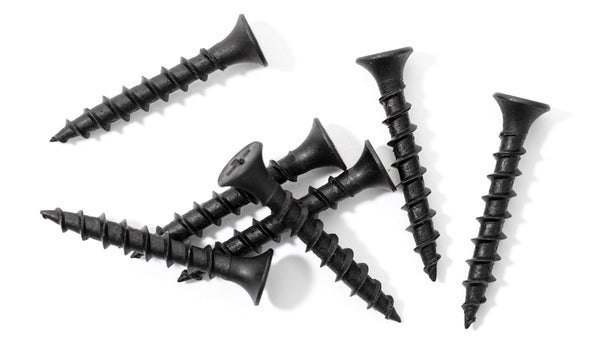Award Winning Service
Award Winning Service


Drywall screws, commonly used to attach drywall sheets to wall studs or ceiling joists, might initially seem complex due to various characteristics like their length, thickness (gauge), thread style, head type, tip design, and material. Often times the result of an entire construction project can be affected by the quality of tools and materials used, including drywall screws. This principle was highlighted in our earlier blog post on Why the Quality of Your Drywall Tools Matters. Today, we focus on a critical component of any drywall installation: the humble yet indispensable drywall screw.
Drywall screws are specially designed for hanging drywall and they are distinct from other types of screws. A quality drywall screw ensures robust installation, prevents nail pops, and prolongs the lifespan of the installed drywall. In contrast, low-quality screws might lead to premature wear, resulting in time-consuming and costly repairs and often times screw pops. For these reasons you should always use quality Drywall Screws and Fasteners to ensure professional results.
Drywall screws are not one-trick ponies. Their primary use is in hanging drywall, but they are also effective in repairing nail pops and in certain building applications where they outperform traditional wood screws. This versatility makes drywall screws a handy item in any builder's toolbox.
The size of the drywall screw you'll need largely depends on the thickness of the drywall you're working with. It's crucial to remember that most of the drywall installed in homes is 1/2-inch thick, which pairs best with either 1 1/4-inch or 1 5/8-inch drywall screws. Selecting the appropriate length ensures secure attachment and long-lasting durability of your drywall installation.

Coarse-thread drywall screws are the go-to option for attaching drywall to wood. Their wide threads excel at gripping the wood, effectively pulling the drywall against the studs. However, be cautious as the metal burrs on coarse-thread screws can embed into your fingers. Wearing gloves while working with these is advised.
On the other hand, fine-thread drywall screws, or S-type screws, are self-threading, making them an ideal choice for metal studs. Unlike coarse threads that can chew through metal without gaining proper traction, fine threads are able to self-thread, providing a secure attachment when installing drywall to metal studs. Each type has its unique application, and DuraFast by Phillips Fasteners range includes both for convenience.

When we talk about screw gauges, we're referring to the diameter of the screw. Commonly, you'll come across #6 and #8 drywall screws in the market. The actual sizes for these are #6 (0.1380-inch) and #8 (0.1640-inch) respectively. The choice between a #6 or #8 gauge depends on the specific requirements of your project, with the #8 gauge being thicker and therefore providing a stronger hold.
Accurately estimating how many drywall screws you need can be a challenge as drywall screws are often sold by weight. Though the exact quantity can vary, Timothy's Toolbox provides estimates on product pages to help you determine the number of screws in the boxes. Remember, these are only estimates and the actual quantity might differ.
Knowing how to drive drywall screws is as important as selecting the right screw. The key is to drive the screw in just far enough to dimple the drywall but not tear the paper. It's a skill that can be easily mastered with practice and the right tools, such as a Drywall Screw Gun.
When driving drywall screws, it's essential to follow these steps:
By following these steps, you'll master the art of driving drywall screws, enhancing the quality and durability of your drywall installations.

As you delve into the world of drywall screws, you'll encounter a range of terms and features, including bugle head, sharp point, and coatings. For instance, the bugle head allows the screw to sink into the drywall without tearing the paper. Furthermore, there are various types of screws available like phosphate-coated screws, which offer enhanced protection against rust.
In conclusion, the quality of your drywall screws can significantly impact the success of your building project. Armed with the knowledge provided in this post, you should be well-equipped to make informed decisions about purchasing and using drywall screws, particularly when buying in bulk. At Timothy’s Toolbox we carry USG Sheetrock Premium Drywall Screws and DuraFast Drywall Screws. We specialize in providing contractors with premium, made in Taiwan, drywall screws. So whether you need a few boxes or multiple pallets we have you covered. Remember, the right drywall screw can make your drywall work more efficient, durable, and aesthetically pleasing. So, choose wisely!
{"one"=>"Select 2 or 3 items to compare", "other"=>"{{ count }} of 3 items selected"}
Leave a comment